Clambering aboard the Delhi-Lahore bus service and dodging belligerent border guards engaged in daily ceremonial stand-offs on the Attari-Wagah border, Yoginder Sikand slipped into potentially hostile territory to check out the charms of Pakistan’s showpiece historical city
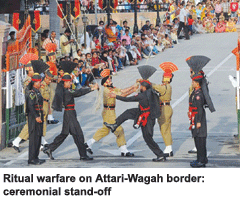 Although the perenially troubled Indo-Pakistan relationship is prone to violent mood swings, particularly after the alleged Pakistan-inspired terrorist outrage of 26/11 in Mumbai, the Delhi-Lahore bus service inaugurated with much fanfare in 1999 keeps plying regardless. Recently I hopped aboard to experience this legendary ride.
Although the perenially troubled Indo-Pakistan relationship is prone to violent mood swings, particularly after the alleged Pakistan-inspired terrorist outrage of 26/11 in Mumbai, the Delhi-Lahore bus service inaugurated with much fanfare in 1999 keeps plying regardless. Recently I hopped aboard to experience this legendary ride.
The bus stopped for a moment on the Indian side of the heavily fortified gate at the border town of Attari. Two tall soldiers dressed in immaculate khaki and turbans, stood erect and correct, a bearing they carefully cultivate. Two others stomped up and down, flaying their arms in the air amidst raucous patriotic music that sounded distantly in the background. In the distance, I spied a batch of school children excitedly heading for the gate in time for the daily closing-of-the-gates ceremony on the Wagah-Attari border. It’s essentially a ceremonial stand-off between national chauvinists, religious bigots and sundry jingoists from both countries.
When the vehicle halted exactly on the broad white lines painted across the road that marked no-man’s land, our Indian driver hauled himself out of his seat, to cede it to his Pakistani counter-part. The bus crept over the white lines, stopped briefly in the middle, and moved ahead, crossing into Pakistan.
Slowly the bus passed under a massive stone archway, on which was emblazoned a slogan as inane as the one I had spotted on the Indian side —‘Pakistan Ka Matlab Kya? La Ilaha Il Allah’ (‘What is the Meaning of Pakistan? There is no god but Allah’). Typical of the kitsch religious nationalism pervasive in Pakistan. Below it hung a massive portrait of a stern-looking Muhammad Ali Jinnah. Emerging from the archway, travellers from India are greeted by grim Pakistani soldiers performing the same menacing drill as their Indian counter-parts on the other side, throwing stiff arms in the air and stomping the ground with their boots. Like the Indian border guards, they were dressed to intimidate. But in their flowing shalwar-kameez, ankle-high boots and peaked caps tightly wrapped with black bandanas, from the top of which emerged decorative plumes, they seemed more comic than menacing.
A short distance away, the bus pulled in at the Wagah immigration and customs check post. Passengers poured out and pushed and shoved at the counter to have their passports stamped. I was the last to emerge, carefully meditating on my first step on Pakistani soil, and somewhat incred-ulous about having crossed the forbidden frontier. I half expected Pakistan to be entirely different from India, which lay just 400 metres behind. Spotting a battalion of porters bearing ponderous luggage on their backs and heads, I thought they looked no different from their counterparts just across in Attari. And, no different too, were the fields of ripening wheat and the brilliant yellow mustard flowers swaying in the gentle evening breeze. Indolent buffaloes lazed in ponds with storks perched on their backs, and cone-shaped thatched huts smoked in the distance.
My host in Lahore was Sheila, a middle-aged Left-wing activist, whom I had met only once before. But we had been in regular touch on email thereafter. Sheila insisted on my staying in her well-appointed home in a suburb of Lahore.
Driving down from the Tourist Centre to her house, I juggled between answering her volley of questions about mutual friends in India and trying to spot every small detail as the skyline of Lahore came into sight. As we careered on, I was struck by how identical everything seemed to things back home.
It was as if I had not left Delhi at all. I gazed at the cars moving in an endless stream, driven mainly by clean-shaven men and some even by fashionable women. As the bus wound its way, the people seemed no different from fellow Punjabis in India. There was nothing about them that even remotely resembled the Muslim stereotype of popular Hindu imagination. It struck me — and this I was to remain conscious of during my entire trip — how relatively less common the beard and skull-cap was here, than in most Muslim localities in India. This I must admit, was rather disconcerting, for I had expected Pakistan to be a foreign country — alien ‘enemy’ territory. But no mystique or magical glitter here, if I was expecting that.
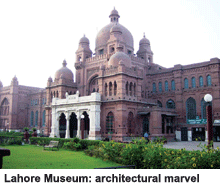 My first destination was the Lahore Museum, located at the far end of Mall Road, opposite the old University Hall, and one of the most well-endowed and largest in South Asia. An architectural marvel, the cluster of buildings is a fine blend of Gothic, Victorian and Mughal styles. Inaugurated in 1887 to commemorate the silver jubilee of Queen Victoria, Empress of India, its foundation stone was laid three years later by Victoria’s grandson, Prince Albert Victor, Duke of Clarence. John Lockwood, father of Rudyard Kipling, served as curator of the museum for several years, and Kipling’s hugely popular novel Kim, was set in the vicinity of the museum.
My first destination was the Lahore Museum, located at the far end of Mall Road, opposite the old University Hall, and one of the most well-endowed and largest in South Asia. An architectural marvel, the cluster of buildings is a fine blend of Gothic, Victorian and Mughal styles. Inaugurated in 1887 to commemorate the silver jubilee of Queen Victoria, Empress of India, its foundation stone was laid three years later by Victoria’s grandson, Prince Albert Victor, Duke of Clarence. John Lockwood, father of Rudyard Kipling, served as curator of the museum for several years, and Kipling’s hugely popular novel Kim, was set in the vicinity of the museum.
The museum boasts the usual curiosities of most Indian museums of comparable size. There are exhibits from Pakistan’s pre-Aryan, Buddhist, Jain, Hindu and Sikh past — statues of gods and godesses, coins and amulets, multi-coloured votive flags, carved wooden doors decorated with multi-limbed deities, fraying embroidered silk robes, and portraits of bearded Rajas and veiled Ranis sporting in bathing pools and flower-filled gardens.
The pride of place is occupied by the delicately chiseled sculpture of a fasting Buddha absorbed in meditation, his deer-like eyes sunk in deep hollows, his stomach stripped of every bit of flesh by stern austerity. An adjacent chamber houses artefacts from the five thousand year old Indus Valley Civilisation that predated the Aryan invasions — clay toys, pottery shards, seals and votive tablets from Mohenjo Daro and Harappa.
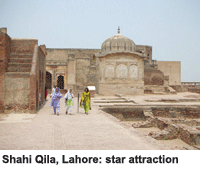 Inevitably the lahore museum also contains a vast collection of exhibits connected with the country’s Muslim heritage: miniature Mughal paintings, turbans and frocks that are the legacies of a series of Sultans, carved Central Asian maces and muskets, hand-written copies of the Quran and Persian Sufi tomes yellowing with age. But to the Indian visitor, the distinctly Pakistani touch of the museum is the hall dedicated to the ‘Freedom Movement’ which occupies the entire upper floor. A tendentiously skewed version of South Asian history, from medieval times to our own, to narrate the evolution and raison d etre of the ‘Ideology of Pakistan’ and ‘Two Nation Theory’, is presented through photographs, documents and artefacts.
Inevitably the lahore museum also contains a vast collection of exhibits connected with the country’s Muslim heritage: miniature Mughal paintings, turbans and frocks that are the legacies of a series of Sultans, carved Central Asian maces and muskets, hand-written copies of the Quran and Persian Sufi tomes yellowing with age. But to the Indian visitor, the distinctly Pakistani touch of the museum is the hall dedicated to the ‘Freedom Movement’ which occupies the entire upper floor. A tendentiously skewed version of South Asian history, from medieval times to our own, to narrate the evolution and raison d etre of the ‘Ideology of Pakistan’ and ‘Two Nation Theory’, is presented through photographs, documents and artefacts.
Legend has it that the city of Lahore was founded by Lav, son of Rama, hero of the Hindu epic Ramayana. Possibly one of the earliest extant historical references to Lahore is to be found in the Geographia authored by celebr-ated astronomer and geographer, Ptolemy of Alexandria (83-168 C.E.), who refers to a city known as Labokla, situated on the route between the Indus and Palibothra or Pataliputra (Patna) — in a country called Kasperia, or Kashmir.
Moreover an anonymous author of the late 10th century Arabic text Hudud al-Alam (‘Boundaries of the World’) referred to Lahore as boasting “impres-sive temples, large markets and huge orchards”. Few other references to Lahore existed in the period before its capture by Sultan Mahmud of Ghazni in the early 11th century after a long siege that almost depopulated the city. Ghazni appointed his Turkic slave and lover, Malik Ayaz as governor, who resettled the city and ordered the construction of various buildings, some of which still survive in various stages of dilapidation.
The rule of the Ghaznavids, descendants of Mahmud, over Lahore proved short-lived. After them, the town fell under the control of several Turkic and Afghan dynasties, including the Khiljis, Tughlaqs, Syeds, Lodhis and Suris, until it was absorbed into the Mughal Empire in the mid-16th century. During this long period, Lahore witnessed feverish building activity that completely changed its landscape. However when Mughal power began to crumble in the 18th century, Lahore bore the brunt of numerous invasions from the Afghan borderlands, until it became the capital of Sikh rajas who added numerous buildings to the city, a pattern that the British replicated when they captured it some decades later.
I spent the next few days exploring Lahore’s Old City, doing a quick round of selected Mughal monuments recommended by my guidebook. There were far too many, so I had to be selective. Yet Lahore’s star architectural attraction is undoubtedly the Shahi Qila (Royal Fort), sited on the dusty banks of the stony bed of the river Ravi that once flowed below it. The history of the Fort goes back to pre-Islamic times, but several Muslim rulers built structures behind its imposing yellow sandstone walls, which are now a Unesco World Heritage site.
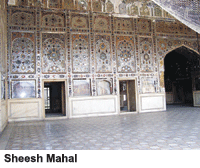 Among the most notable of these structures are the Sheesh Mahal, almost every inch of its walls covered with tiny mirrors; the marble-floored, richly embellished Diwan-e-Khas, where royalty held court and received foreign visitors; the small but exquisite Naulakha pavilion, topped with a marble umbrella roof which offers panoramas of the bustling city below; the unpretentious Moti Masjid, a mosque with graceful, pencil-like minarets.
Among the most notable of these structures are the Sheesh Mahal, almost every inch of its walls covered with tiny mirrors; the marble-floored, richly embellished Diwan-e-Khas, where royalty held court and received foreign visitors; the small but exquisite Naulakha pavilion, topped with a marble umbrella roof which offers panoramas of the bustling city below; the unpretentious Moti Masjid, a mosque with graceful, pencil-like minarets.
However in comparison with Delhi’s Red Fort, the Shahi Qila pales. Its fountains have run dry, the flower beds are almost empty and in the sprawling gardens pale yellow grass grows in scattered, mangy clumps. Paintings of Hindu deities and of the legendary Sikh ruler of Punjab, Maharana Ranjit Singh, embellishing some walls have suffered the wrath of vandals, who have rendered them headless, as if symbolically executing and excising them from public memory. The only eatery in the vast complex was a dark, one-roomed building. Paint peeled off its soot-stained walls.
My next port of call was the Moorish-style tomb of Pakistan’s national poet, Muhammad Iqbal. Befitting a man who was a suspected Sufi philosopher —and a bitter critic of austere Islam — Iqbal’s grave is a simple marble structure, perpetually buried under marigold and rose garlands — the offerings of a steady stream of visitors, for whom Iqbal remains a blessed saint.
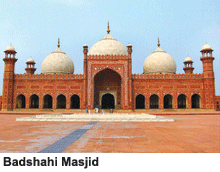 The mausoleum is housed in the basement of the grand Badshahi Masjid (Emperor’s Mosque), whose towering minarets are visible from miles away. Built in 1673 by Emperor Aurangzeb, the mosque is a fine specimen of Indo-Islamic architecture and bears some resemblance to Delhi’s Jama Masjid, built by Aurangzeb’s father, Shah Jahan. Capable of hosting over 50,000 worshippers, this is the largest mosque in Pakistan after the Faisal Mosque in Islamabad.
The mausoleum is housed in the basement of the grand Badshahi Masjid (Emperor’s Mosque), whose towering minarets are visible from miles away. Built in 1673 by Emperor Aurangzeb, the mosque is a fine specimen of Indo-Islamic architecture and bears some resemblance to Delhi’s Jama Masjid, built by Aurangzeb’s father, Shah Jahan. Capable of hosting over 50,000 worshippers, this is the largest mosque in Pakistan after the Faisal Mosque in Islamabad.
I climbed a narrow, dimly-lit flight of stairs that lead to the mosque’s modest-sized museum. Displayed in giant glass cases are numerous relics — genuine or, equally possibly, spurious — of the Prophet Muhammad, including a frayed green coat, a pair of loose trousers, a blanket, a long bolt of cloth that might have been used as a turban, a pair of leather sandals, a single strand of hair and the purported foot-print of the Prophet embedded in a stone slab. Also on display are rusty swords, knob-ended staffs, calligraphed books and a variety of costumes attributed to noted Muslim saints, including the Prophet’s son-in-law Ali, the Prophet’s daughter and Ali’s wife Fatima, and several Sufi saints.
Barely a minute’s walk from the mosque is the large, white-washed Gurdwara Dera Sahib Panjvin Padshahi. Lahore during the 19th century was the administrative capital of a mighty Sikh Empire under the ‘Lion of the Punjab’ Maharana Ranjit Singh, and boasted a large Sikh community and several Sikh gurdwaras. With its Mughal-style gilded domes and slender minarets, gurdwara Dera Sahib could easily be mistaken for a Muslim monument. It stands on the spot where the fifth Sikh guru, Arjan Dev, was martyred in 1606 on the orders of Mughal Emperor Jahangir. It also contains the samadhi of Ranjit Singh, and his wives and concubines who were said to have committed sati on his death, leaping to their deaths in blatant disregard of the teachings of Sikh gurus.
Emerging from the gurdwara, I settled on a bench on the lawn. A while later, a middle-aged Sikh drew up and sat next to me. He introduced himself as a trader from Peshawar, and began talking about Pakistan’s minuscule Sikh population. The Sikh community had dwindled to less than 50,000, he said, with the largest concentration in the North-West Frontier Province, mainly in Peshawar and contiguous towns, the lawless region which had been subjugated by Maharana Ranjit Singh in the early 19th century and incorporated into the vast Sikh Empire, which, at its zenith, stretched from Delhi to the borders of Afghanistan and Tibet. During Sikh rule, a large number of Sikhs from Punjab had settled in the Frontier Province as traders, soldiers and government officials.
Changing three buses later that morning, I made it to the mausoleum of Lahore’s most venerated Sufi saint, the 11th century Syed Abul Hasan bin Ali al-Hujweri or Data Ganj Bakhsh (‘Giver of Treas-ures’) or simply Data Sahib, as he was popularly known. Data Sahib authored Kashf al-Mahjub (‘Unveiling of the Veiled’), the earliest extant Persian treatise on Sufism, acclaimed as a masterpiece on Islamic mysticism. Rags-clad stragglers festooned with strings of colourful beads and brass medallions dangling from their necks, their fingers embellished with rings bearing red and green stones the size of birds’ eggs, squatted in a concrete traffic triangle at the foot of the shrine. One of the men, who sported an enormous parrot green turban that looked like an untidy pile of laundry, furiously tugged at a clay pipe, shutting his eyes as he savoured the stuff.
The courtyard of the shrine buzzed with activity. Large crowds wound their way to the mosque at the far end, an ugly, newly-constructed concrete structure that had none of the charm and grace of the centuries-old tomb of Data Sahib. Olive green glass panes ran along the length of the building, which boasted towering missile-shaped minarets on all four sides.
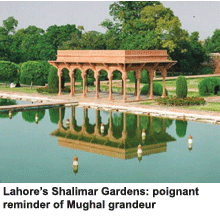 I had just another day in Lahore and there was considerably more left to see. The guide books recommended the Shalimar Gardens, built by the Mughal Emperor Shah Jahan, located in the heart of the city. The books gushed their praise describing them as “almost heaven-like”, “resplendent in their glory”, and as a “living reminder of Mughal art at its very zenith”.
I had just another day in Lahore and there was considerably more left to see. The guide books recommended the Shalimar Gardens, built by the Mughal Emperor Shah Jahan, located in the heart of the city. The books gushed their praise describing them as “almost heaven-like”, “resplendent in their glory”, and as a “living reminder of Mughal art at its very zenith”.
My auto-rickshaw crawled through a busy commercial area, and drew up before a rusted gate set in a low stone wall badly bruised in places. Political slogans and commercial advertisements were splattered on walls and the pavements hosted dozens of hawkers, peddling cheap plastic toys, religious posters, socks and sweaters, picture postcards and Chinese-made alarm clocks and torches. On the other side of the street was a long row of dingy eateries, unpainted houses and workshops operating from makeshift tin sheds. Hardly the splendorous Mughal setting that the guidebooks described.
Nevertheless the Shalimar Gardens exude a certain charm, if only because it’s struggling hard to retain its glory in an era of pathetic neglect. The fine buildings scattered inside the complex are also a poignant reminder of the grandeur of the Mughals, whose legacy the Pakistan state inherited but had —as much of what I had already seen of Pakistan so clearly suggested — in many ways brutally forfeited.
I did a hurried round of the remaining monuments on my list. On the other side of Lahore, straddling the River Ravi, stands its finest Mughal monument — the 17th century mausoleum of the Mughal Emperor Jahangir. Set within an attractive walled garden, it is of modest size by Mughal standards, and lacks a central dome. Yet this omission is compensated by its four elegant minarets, each over 30 meters high and built of flanks of red sand-stone and slender carved slabs of marble. The inner walls are embellished with elegant mosaics cleverly pieced together to form flowers, buds, leaves and tendrils set in frames citing verses from the Quran.
If Jahangir’s mausoleum recaptures some of the lost glory of the mighty Mughal empire, the decaying ruins of two other tomb-structures in the vicinity are mute testimony to the tragic end of the dynasty. The tomb of Noor Jahan, (‘Light of the World’), the favourite wife of Jahangir, is now in a shambles. A board nailed to the tomb entrance explains that this once fine structure suffered extensive damage at the hands of marauders, after Lahore passed into Sikh hands. Many of its precious tiles and coloured stones were looted and used to adorn various Sikh shrines, claims the notice.
I had tarried in Lahore for more than a fortnight and although Shiela insisted that I prolong my stay, I couldn’t take further advantage of her kindness. I resolved to head southward to Sindh, to visit the ancient historic sites of the Indus Valley Civilisation and Sufi shrines, for which the province is famous.